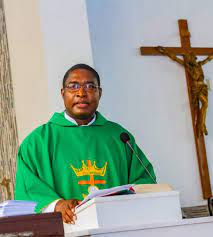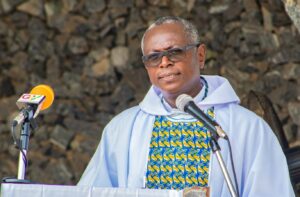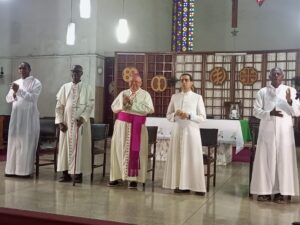The Bishop of Konongo-Mampong Diocese, the Most Rev. Joseph Osei-Bonsu has given detailed explanations to the roles of Auxiliary.
His explanation was in response to questions asked by two Ghanaian Catholics, Cornelius Dordunu and Joshua Elikplim.
On February 14, Pope Francis appointed two Auxiliary Bishops for the Catholic Archdiocese of Accra, Msgr. John Kobina Louis and Msgr. Anthony Narh Asare.
Until their appointments, Msgr. Louis was the Vicar General of Accra Archdiocese and Msgr. Asare was the Parish Priest of Ss. Anne and Joachim at Teshie, Accra.
Below are the questions and answers by Bishop Osei-Bonsu
Question by Cornelius Dordunu: My Lord, what are the duties and powers of auxiliary bishops? How do auxiliary bishops differ from coadjutor bishops?
Question by Joshua Elikplim: My Lord Bishop, today, 14th February 2023, His Holiness Pope Francis appointed two Auxiliary Bishops for the Catholic Archdiocese of Accra, namely, Very Rev. John Kobina Louis and Very Rev. Anthony Narh Asare. A lot of questions are being asked: what are the implications of these appointments? Will Fr. John Kobina Louis still remain the Vicar General? Why are they assigned to Titular Sees? What are Titular Sees? Will the Archdiocese of Accra be divided into two or three? I shall be grateful for your detailed response to these questions.
Answer:
Since both questions deal primarily with auxiliary bishops and their roles, I will begin by discussing who auxiliary bishops are.
According to Canon 403.1, when the pastoral needs of a diocese require it, one or more auxiliary bishops may be appointed at the request of the diocesan bishop. In other words, auxiliary bishops are named when a diocesan bishop finds that the needs of his diocese are too great for him to handle alone. An auxiliary bishop, therefore, is and does exactly what his title indicates: he is a bishop who assists the diocesan bishop. The word “auxiliary” comes from a Latin word meaning “one who helps”.
Indeed, many bishops can manage their dioceses by themselves, but there are some dioceses that are too large, or have too much activity, for one person to handle! There are also instances of diocesan bishops with health problems which limit their ability to oversee every aspect of their dioceses. In such cases, the diocesan bishop can ask the Holy Father for an auxiliary bishop to assist him. Sometimes dioceses are so big that it is necessary for the diocesan bishop to have a number of auxiliaries. The Archdiocese of New York and the Archdiocese of Cologne are typical examples.

Sacramentally speaking, an auxiliary bishop is truly a bishop, for he receives episcopal consecration just like the diocesan bishop. An auxiliary bishop, therefore, has the power validly to ordain priests, to confirm, and to consecrate other bishops. However, the jurisdiction, or governing authority, of an auxiliary bishop is another matter. Within a given diocese, the diocesan bishop alone has full responsibility for the entire diocese which the Pope has entrusted to his care (cf. c. 381.1). An auxiliary bishop, therefore, is not to be seen as a co-leader of a diocese, as he does not have full authority over that diocese; only the diocesan bishop himself does.
Auxiliary bishops can be given governing power, but it is generally limited to certain geographic sections of the diocese, or to certain aspects of it. For example, an auxiliary bishop might be given particular authority over all the Catholic schools of the diocese, or he might be entrusted specifically with the spiritual care of an especially large immigrant community. Irrespective of an auxiliary bishop’s duties, however, the diocesan bishop retains ultimate authority.
Speaking of authority, canon 403.2 addresses a specific type of auxiliary bishop: an auxiliary with special faculties. The Pope may decide that in a particular diocese, he will appoint an auxiliary bishop who has more specific authority—and the Holy Father will specify exactly what the nature of that authority is. It should be noted that this type of auxiliary bishop is not necessarily appointed at the request of the diocesan bishop (although he might be). Let us imagine, for example, a situation where a diocesan bishop has demonstrated a particular incompetence in handling financial matters. The Pope might decide to give such a bishop an auxiliary bishop with power to make monetary decisions that ordinarily could only be made by the diocesan bishop himself.

We can see the general nature of an auxiliary bishop’s powers and duties. What, then, is the difference between an auxiliary bishop and a coadjutor bishop? A coadjutor bishop, as described in canon 403.3, also is given special faculties. In this sense, he is much like the auxiliary bishop with special faculties, but there is one big difference: when the diocesan bishop retires or dies, a coadjutor bishop immediately becomes his successor (c. 409.1). The presence of a coadjutor bishop, therefore, ensures that there is no period during which the episcopal see is vacant. Under this arrangement, the transfer of authority to a new diocesan bishop from his predecessor is as seamless as possible.
In the Catholic Church’s understanding of the office of bishop, it is important for a bishop to be attached to the People of God in a given place, even if he does not live there. So when bishops are ordained for a purpose other than serving as the diocesan bishop, they are given the title of one of ancient dioceses that no longer exist. These are known as titular sees. Those bishops who receive titular sees in the Church today function in one of the following capacities: cardinals or bishops who are nominated as bishops to serve in the Roman Curia without having been attached to another diocese, nuncios, apostolic delegates and other dignitaries of the Curia, coadjutors and auxiliary bishops.
Canon 407 specifically notes that the diocesan bishop and his auxiliary or coadjutor bishop(s) are to consult with each other on important diocesan matters, and that the auxiliary/coadjutor should exercise his office in such a way that he acts and thinks in accord with the diocesan bishop. All have a significant role to play in the spiritual wellbeing of the diocese to which they are assigned, and are expected to work together for the good of the Church.
Let us now come to the specific case of the appointment of Very Rev. Fr. John Kobina Louis and Very Rev. Fr. Anthony Narh Asare as Auxiliary Bishops of the Catholic Archdiocese of Accra. The decree appointing them states that they have been assigned the Titular Sees of Fessei (Fesseitanus) and Castello di Numidai (Cestellanus in Numidia), pr. Numidia respectively. As we have seen above, it is in line with the Church’s practice to attach them to titular sees or dioceses. Their sees were ancient dioceses located in Numidia. This was the ancient kingdom of the Numidians located in northwest Africa, initially comprising the territory that now makes up modern-day Algeria, but later expanding across what is today known as Tunisia, Libya, and some parts of Morocco.

The Accra Archdiocese remains undivided and its Archbishop is and remains Archbishop John Bonaventure Kwofie, CSSp. The decree appointing the two auxiliary bishops does not mention or imply the division of the Archdiocese of Accra. The two auxiliaries are auxiliary bishops for the Accra Archdiocese but they are not bishops of the Accra Archdiocese. There is only one bishop (archbishop) of the Accra Archdiocese and that is Most Rev. John Bonaventure Kwofie. They are auxiliary bishops of the Titular Sees of Fessei and Castello di Numidai in Numidia.
As to whether Msgr. John Kobina Louis will be the Vicar General or not is a question that only Archbishop John Bonaventure Kwofie can answer. As we saw above, it is the responsibility of the diocesan bishop or archbishop to assign certain duties to the auxiliary or auxiliaries, depending on the pastoral needs of the diocese or archdiocese.
| For further explanations or enquiries, you may contact the author, Most Rev. Joseph Osei-Bonsu, Catholic Bishop of Konongo-Mampong, on this number: 0244488904, or on WhatsApp (with the same number). Email: bishop@kmdiocese.org |



